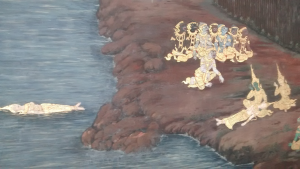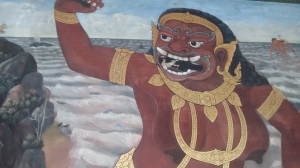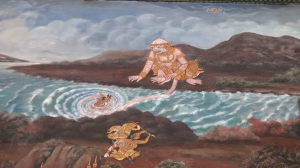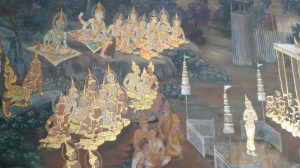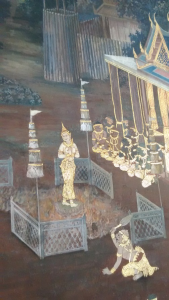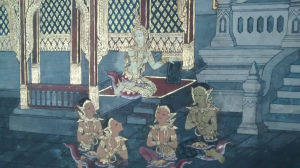There is a sharp self-reflexive question at the end of some versions of the Ramayana: “How many Ramayanas have there been?”
In his essay “Three Hundred Ramayanas: Five Examples and Three Thoughts on Translation” 1, Ramanujan responds to this question by tracing several branches of this banyan tree of an epic. For the past 2,500 years or more, the Ramayana has lived in multiple versions in at least 22 languages across India and Asia. The epic has spoken to people through poems, myths, sculpture, mask plays, puppet plays, shadow plays, music, dance, TV serials, films and comic books.
Can the hanging branches of a banyan turn invisible? Can an epic be shrunk to size?
In 2011, Ramanujan’s essay was dropped from the syllabus of Delhi University’s B.A. Honours course as a result of protest and vandalism by “nationalist” Hindu groups. These groups were led by the student wing of the Bharatiya Janata Party, the party that rules India today.
The protesters claimed that the idea of multiple Ramayanas would “negatively influence the minds of young undergraduates”. Their real problem is that the essay effortlessly debunks the pseudo-cultural (and pseudo-religious) propaganda that there is one “authentic text” of the epic. The right wing has always feared the plurality at the heart of life in India and, indeed, any Asia we may choose to either remember or forget. As the epic travelled across classes, regions, communities, languages and dialects within India, then regions outside India in Southeast Asia and North Asia, it adapted and shape-shifted. The text became a manifestation of the many Indias contained in every little slice of India, and of the many Asias layering every part of Asia. There is a variety of “tellings” in Tibet, Thailand, Burma, Laos, Cambodia, Malaysia, Java and Indonesia.
But the past in India today is the site of slippery memory games. If the past is reduced to a strand of a complex narrative, or to one authoritative (often invented) narrative, even a travelling epic that needs to multiply itself can be shrunk down to the desired size. A. K. Ramanujan, curator of plural texts, narrator of plural India, will always be a threat to those who want to imagine a homogenous story, myth, history, literary text; or an officially sanctioned view of India in the singular.
Ramanujan makes it clear that the Ramayana can never be merely “official”. The Valmiki Ramayana was an epic first. It may have become a sacred text for some people over a period of time. But even in this case, we could ask a few pertinent questions. Who are the people who made it a sacred text? And who were they doing it for? Most important, what about all the people for whom the text did not become sacred — people who continued to recite, sing and story-tell their own legacies of the epic?
As epic, Valmiki’s Ramayana is bound up with a sparkling array of other Ramayanas, many of which recount stories that are potent even when they are nugget-sized. One story, for example, describes how sixteen thousand sages want to turn into women because they have fallen in love with Rama. Rama asks them to wait — he has taken a vow of monogamy in this life. But when he comes back as Krishna, he tells them, they can be his beloved cowherds.
In the past, Hindus did not react with shrill intolerance to this range of tellings of the Ramayana — whether the epic was recounted by Kamban, Kritihas, or Tulsi. These were accepted as kavya, and then as sacred texts; their differences with Valmiki were known. In our times, we might pose some more pertinent questions to those who want one authoritative “sacred” reading of the Ramayana. Why do they want to break with tradition? Why do they pretend to “defend” tradition and culture by turning both upside down?
In the Jain retellings, Ravana is a tragic figure, killed by Lakshmana, not Rama. In a Kannada folk Ramayana, Ravula (the Ravana figure) becomes pregnant, and at the end of nine days, “sneezes” Sita into existence. (In Kannada, the word sita also means “He sneezed.”) This motif of Sita as Ravana’s “daughter” occurs elsewhere — in, for instance, Jain stories, Telugu folk traditions, and in several Southeast Asian Ramayanas. “The oral traditions,” writes Ramanujan, “partake of… themes unknown in Valmiki.” How, asks Ramanujan, do these tellings and retellings, oral and written, epic and tale, relate to each other?
They do it in ways that impoverish a part — one story or tradition or genre — if it is mistaken for the whole. The grand saga of the epic has to be viewed along with their homely versions, folk tales and traditions that cut down to size the grand narratives for daily consumption. Love, lust, death, the afterlife — nothing is too big for the debate conducted among these tales, and between this earthy body of tales and the more revered “classical” texts and traditions. Acknowledging the familial relationships among all the possible types of “tellings” means reaping the reward of an astonishing body of systems and counter-systems; traditions and alternative traditions; tales and counter-tales; private and public lore; a large and amorphous body that can never quite be complete as long as people continue to “complete” the telling for their times and lives.
Perhaps the biggest gift Ramanujan the go-between has given us through his work on our rich heritage is showing us how important it is for culture to travel; to give and receive. Almost as a recipe for world literature, Ramanujan quotes the 12th century poet and historian Kshemendra:
A poet should learn with his own eyes
the form of leaves
…his mind should enter into the seasons
he should go
among many people
in many places
and learn their languages.2
I could hear Kshemendra’s voice in my ear when I was in Bangkok recently. My life as an Indian, and my life as a writer and reader, only has meaning if I can hold the multiple possibilities of a narrative as the self-evident truth of all storytelling. The time I spent on the grounds of the Wat Pra Kaew, the Temple of the Emerald Buddha in Bangkok, brought home the truth of Kshemendra’s words, and Ramanujan’s essay on the many Ramayanas. The walls of the Wat Pra Kaew, lavishly decorated with paintings representing stories from the Ramakien, confirmed my conviction that the same text lives and breathes as another text, among different people, in many places and languages.
The Ramakirti (The Glory of Rama) is usually referred to as the Ramakien (The Story of Rama) in Thailand. Archaeological evidence of the story dates from the 14th century in the Wat Phra Rama at Ayuthia.3
Ayuthia (Audhya, Ayudhya, Ayutthaya) — the Thai Ayodhya — was a riverine island city-state founded in 1350 AD by Prince U-Thong who took the title Ramathipodi (Rama the Sovereign). For some 417 years, Ayuthia was the “heart of Siam” till it was destroyed during a battle with Burmese invaders in 1767. A new capital was subsequently established on the site of a riverside market town called Ban Kok (Village of Wild Plums). King Rama I made a deliberate attempt to recreate the Ayudhyan way of life, and this included sponsoring, and closely supervising, a written version of the Ramakien. The version was in verse, and it was meant for secular use to be performed as masked drama.
In present-day Thailand, images and tales from the Ramakien are alive in a range of locations and forms, from ubiquitous state symbols such as the garuda, to Lakhon classical drama, Khon masked dance dramas, Nang shadow plays, Buddhist temple statuary, decorative elements and murals, illustrative material for religious manuscript cabinets and talismanic tattoos. Since 1902, the Ramakien has been part of the Thai school curriculum; it is considered the “national epic”. The Ramakien is Thai, not some Thai version of the “Indian” Ramayanas.
As in India, some readings of the Ramakien recall the emphasis on the sacredness of the text. But the difference is also fairly sharp: the Thai Ramayana is a narrative with its own audience, and its own emphasis on adventure, magic and, ultimately, how men and women should live in the real world. In effect, the Thai Ramayana tells us that the sacred tellings have not diminished the space for “non-sacred” retellings of the epic.
In his essay on the many Ramayanas, Ramanujan points out that the different Ramayanas are better described as “tellings” rather than “versions”, which may imply that one telling can be valorised as the authoritative mother-text. The tellings obviously take on the storyteller’s language, landscape, clothes, food and customs. Each telling is the result of a particular travel route; the Ramakien, for instance, owes more to the Tamil telling than Valmiki’s. The plot also has elements from the Malay Hikayat Sri Rama (The Annals of Sri Rama), the Thai prose work Narai Sip Pang (Ten Incarnations of Vishnu), and certain sections of folk tales from the Laotian Rama Jataka. Most of all, says Ramanujan, it’s not just differences in story detail that marks each telling as a unique text. It’s the style, tone, texture and discourse. Together, these make the import of the story different in the telling.
This is exactly what the Ramakien illustrates.
As I looked at an almost endless series of detailed, glittering paintings in the Wat Pra Kaew, there was much that puzzled me. I could make out the usual outline of the story — Rama (Phra Ram), Sita (Nang Sida) and Lakshmana (Phra Lak)going to the forest; Phra Ram and Phra Lak slaying demons; Nang Sida’s abduction; the war; Hanuman (Anuchit) and the monkeys helping Rama; Nang Sida’s recovery and her trial. But there was a great deal I could not recognize in terms of episode and character. I met, for instance, Benjakaya, Suphanna-Maccha and Maiyarab for the first time in the Wat Pra Kaew paintings of the Ramakien.
When Tosakanth (Ravana) begins to worry about the way the war is going, he decides to fool Phra Ram into thinking Nang Sida is dead. Perhaps this will blunt Phra Ram’s appetite for battle. Tosakanth orders his niece Benjakaya to transform herself into Nang Sida, pretend to be dead, and float in the river past Phra Ram’s camp. Benjakaya studies Nang Sida so well that Tosakanth is filled with lust when he sees her transformed appearance. With some difficulty, Benjakaya manages to convince him that she is still his niece, and escapes his clutches to carry out his order. When Phra Ram sees the dead Benjakaya-Nang Sida floating in the river, he is heart-broken. But Anuchit is suspicious: the body is floating against the current. He knows Nang Sida is impervious to fire; so he sets alight Benjakaya-Nang Sida. Benjakaya escapes into the skies, but Anuchit chases her though the clouds. They are “married” (mid-sky?) and she comes back to the camp as his ally.
Another female relative of Tosakanth is enlisted to prevent the building of the causeway to Lanka. Tosakanth asks his mermaid daughter Suphanna-Maccha to go do her disruptive best. As usual, Anuchit sees what is happening, and as usual, he converts another female enemy into an ally. Suphanna-Maccha later has a son, Macchanu, who resembles Anuchit.
Tosakanth then orders Maiyarab of the underworld to put Phra Ram to sleep and carry him away. There are no prizes for guessing who saves Phra Ram and kills Maiyarab. In fact, I was struck by how ubiquitous Anuchit is in the tales the paintings told. He is everywhere visually. He is the actor who precipitates dramatic change; at the end of the tale, Phra Ram gives Anuchit a kingdom of his own.
Anuchit is an invincible warrior; he has an unbreakable bond with the ruler. His strength, his superpowers, can take on all kinds of enemies, as well as all kinds of women. There is an undercurrent to a number of his amorous encounters — he turns the female enemy, whatever demonic form she assumes and whatever magic she knows, into a submissive ally.
Episodes and details in the Ramakien make for stark or subtle shifts in mood and characterisation. Details, such as Phra Ram and Nang Sida falling in love at first sight before the archery contest, are reminiscent of the Kamban Ramayana. The focus of the Ramakien, though, is the war: layer upon layer of intrigue and strategy, destruction and magic, unfold the story. I saw spy scenes, interminable battle scenes. I was not surprised to learn that the war campaigns make up the favourite themes of the Nang and Khon plays. But I was surprised to learn that Anuchit and Ongkot (Angada) pretend to defect to Tosakanth and steal the receptacle that contains Tosakanth’s soul. When Phra Ram’s arrow strikes Tosakanth’s chest on the battlefield, Anuchit crushes the soul in the receptacle. This is what finally kills Tosakanth.
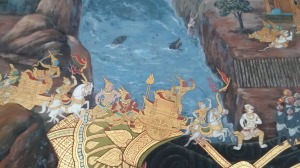
Perhaps one the most distinctive features of the Ramakien, other than Anuchit’s substantial role, is Nang Sida’s life — her birth, her banishment, and her final reunion with Phra Ram.
Nang Sida does not appear miraculously in the furrow for Chanok (Janaka) to adopt her, as in the Valmiki or Kamban tellings. The Ramakien’s Sita is related to the Jain and oral tellings: Nang Sida has a link at birth to Tosakanth. When the gods decide that Vishnu and Lakshmi must be reborn as Phra Ram and Nang Sida, a magical rice dish is sent to earth. Three portions go to Tosaroth’s wives, and they give birth to green-faced Phra Ram, scarlet-faced Bhrot, gold-faced Lak and purple-faced Satrud. The fourth portion, via a divinely managed theft by a crow, is flown to Longka, to Tosakanth’s wife, Montho. She gives birth to Nang Sida.
The instant Nang Sida is born, she cries thrice: “Destroy the demon race!” A disturbed Tosakanth asks his brother to cast a horoscope for this born rebel. The professional opinion is that Nang Sida will cause the demons great misfortune. Tosakanth wants to kill her on the spot. But the mother stands in his way. You will have to kill me before you kill my daughter, she says. The horoscope-casting brother (Pipek, who will later go over to Phra Ram’s side) suggests Nang Sida be put into a silver casket and floated downstream on a river. This is an ancient practice to do away with evil.
A lotus rises; it keeps the casket afloat. Schools of fish escort the casket till it passes a hut where the hermit Chanok, erstwhile King of Mithila, lives. He places the baby under the care of forest spirits and buries the casket for safety. Chanok meditates for many years, but enlightenment is elusive. He returns to Mithila and his childless queen. But first he arranges for the ground to be ploughed to locate Nang Sida, now a sixteen-year-old daughter of the earth.
The banishment of Nang Sida and her reunion with Phra Ram are also distinct in detail — as well as in the unspoken shaping of human character.
After the war, Nang Sida undergoes a trial by fire and is exonerated. (Phra Ram sets alight the logs of wood with his arrow.) But in Ayodhya, Nang Sida has a new maid. The maid is actually a demon called Adun, and she is the daughter of Surpanakha (Sammanakkha). The daughter has not forgotten how her mother was disfigured. She coaxes Nang Sida to draw a portrait of Tosakanth. The portrait is indelible; Nang Sida hides it under Phra Ram’s bed, and it fills his body with a strange heat till he discovers it. Phra Ram doubts Nang Sida’s purity a second time. He orders Phra Lak to take Nang Sida to the forest and kill her. But Phra Lak spares Nang Sida, and returns to Phra Ram with the heart of a deer.
Meanwhile, Nang Sida is in the care of Sage Wachamarik, yet another surrogate father. This father will later create a miraculous clone of her son so that Nang Sida has “twins”. Phra Ram finds out that his family is alive and tries to persuade them to return. Nang Sida refuses, but she lets her sons go with their father. Phra Ram then sends Anuchit to say the king is dead, and Nang Sida should come to Ayodhya for the cremation ceremony. When Nang Sida finds out that she has been tricked, she is furious. Rather than live with Phra Ram, she prefers life in the underworld. Finally Isvara breaks the impasse; he intervenes, and gets Phra Ram and Nang Sida married all over again.
Phra Ram is all too human in the Ramakien. Anuchit, the favourite of the Thais, is a brave, shrewd and happy warrior, neither celibate nor saintly, and, in the words of S. Singaravelu, “an embodiment of all that expresses the freer and the unrestricted aspects of life”. Tosakanth is complex; he is strong and resourceful, and his end is an occasion of sadness, as is his wife’s thwarted motherhood. The major characters of the Ramakien, says Singaravelu, “represent human life in its different facets, and the Thai people regard them as examples of… human society, and this is the reason for the continuing popularity of the Rama legend” in Thailand. Singaravelu goes on to show that though several episodes and motifs in the Ramakien are related to other tellings, such as Kamban’s, or the Jaina, Bengali and Malay tellings, “the stories of Rama, transmitted to the Thai people through the shadow-play as well as literary and oral sources, have not only been extended, but also transformed into a distinct work of literature.”4
The Ramakien is not just a distinct telling in literary terms. There is also a distinct way in which the epic lives in Thailand — achieving a delicate balance between an all-pervasive literary and performative strand on the one hand, and an iconic and cultic strand on the other. In response to the question of whether the Ramakien can be considered a “Hindu” or “Buddhist” text, Frank E. Reynolds outlines an argument against viewing the Ramakien as an unambiguously Hindu text, or perhaps a Hindu text at all. He refers to the epilogue attached to the original composition by King Rama I: “The writing of the Ramakien was done in accordance with a traditional tale. It is not of abiding importance; rather, it has been written to be used on celebrative occasions. Those who hear it and see it performed should not be deluded. Rather, they should be mindful of impermanence.” Rama I uses the word “lailong” for the notion of delusion — a direct translation of the Pali “moha” that refers to one of the three pre-eminent Buddhist vices (delusion, anger and greed). “Rama I explicitly highlights his own conviction that those who participate in the Ramakien tradition can and should approach the Ramakien story in a way consistent with Buddhist teachings and insight.”5 While
“…the Ramakien versions of the Rama story do not exhibit the full-fledged Buddhist structure characteristic of earlier Buddhist tellings”… “it is a tradition which self-consciously sets the Rama story in explicitly Buddhist contexts, thereby giving it an explicitly Buddhist significance. In the literary and performative strand of the tradition, the Buddhist significance remains relatively muted and largely audience-dependent. In the iconic and cultic strand, the vision of Rama as a royal hero who embodies Buddhist values is vividly portrayed for all to see. Coexisting and subtly interacting, these two strands of the Ramakien tradition have, over the past two centuries, maintained the story of Rama as an integral, Buddhist-oriented component in Thai religion, culture, and politics.”6
I learnt a great deal about the Ramayana from the Ramakien. I learnt a great deal about the nature of the epic; its links with, and differences from, the sacred telling; and the vast space people have always given the travelling text.
I learnt something about home in Bangkok too. I saw, once again, how the new tradition-makers in India seek to tame and diminish a rich epic which has always been given voice through multiple narratives. Distorting tradition and culture in the name of tradition and culture: this is the irony of the way these new cultural experts squander our rich legacies. As for the stark contrast between the way the Ramakien lives among the Thais, and the way the Hindutvadis would like the Ramayana to live in India, Ramanujan has, as usual, the last word. The Thai telling, he says, is “not regarded as a religious work or even as an exemplary work on which men and women may pattern themselves.”7

